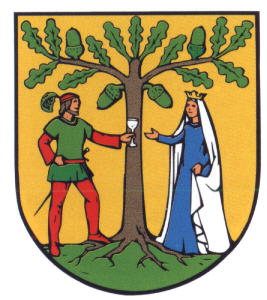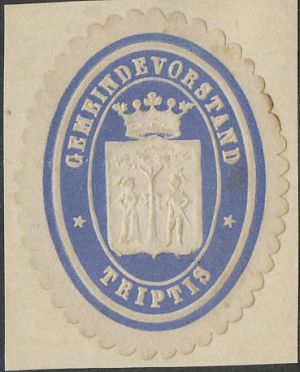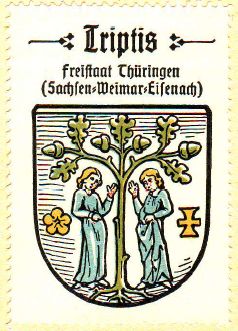Triptis
| Heraldry of the World Civic heraldry of Germany - Deutsche Wappen (Gemeindewappen/Kreiswappen) |
TRIPTIS
State : Thüringen
District (Kreis) : Saale-Orla Kreis
Verwaltungsgemeinschaft : Triptis
Additions : 1950 Oberpöllnitz, Döblitz; 1956 Hasla; 1965 Schönborn, Ottmannsdorf; 2012 Pillingsdorf
Official blazon
In Gold auf grünem Rasen eine Eiche mit grünen Blättern und Früchten, unter dieser ein Edelmann, der eine Dame mit Schleier und Krone einen Pokal reicht.
Origin/meaning
The arms were officially granted on November 13, 1990, but have been in use for centuries.
The oldest seal of the city dates from 1360 and shows a tree with two figures. The meaning of the figures on the seal is not known, although some stories and legends exist.
The present composition is based on the following legend:
In the late 12th century Dietrich (later Margrave of Meissen) choose in the dispute on the succession of the King of the Holy Roman Empire, the side of Philip of Schwaben. Dietrich's sister, Adela, was married to King Ottokar I of Bohemia, who choose the side of the other candidate, the Duke of Braunschweig. As they were now opposing each other, Ottokar send back his wife to Dietrich. The two met near Triptis under a large oak, where he gave her a drink of welcome and invited her into his castle.
Another legend tells of Bertha, daughter of Count Wipprecht von Groitzsch who once, while walking in the forest came upon a small spring. Looking into the spring she saw the face of Count Dedo von Wettin with a beaker. Returning home she learned that in the meantime Dedo had asked her father permission to marry her. They got married, but Dedo was often away for long periods of time. She thus became very lonely. Often she went back to the spring praying for him to come back soon. At a time he returned and they met at the spring. Dedo promised not to leave anymore, but he still had one errand in the Holy Land, so he left for the last time. She kept returning to the spring and one evening she heard horns blowing and her husband returned. He was severely wounded and very weak. He just managed to walk towards her and she handed him a beaker of water. Unfortunately he was too weak and did not manage to drink the water, instead he fell to the ground and died.
| Seal from around 1900 |
Seal from around 1900 |
The arms in the Kaffee Hag albums +/- 1925 |
Literature : Hupp, O: Kaffee Hag albums, 1920s; Benzing et al, 1984; Ulle, 1997




